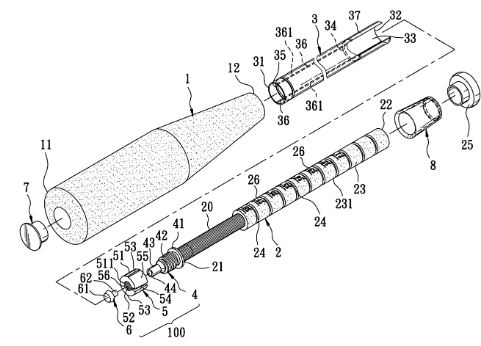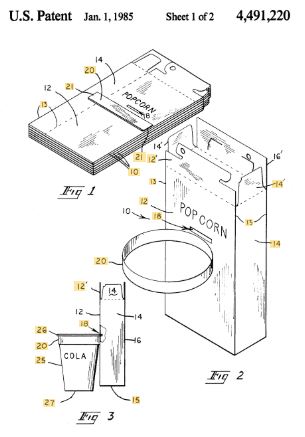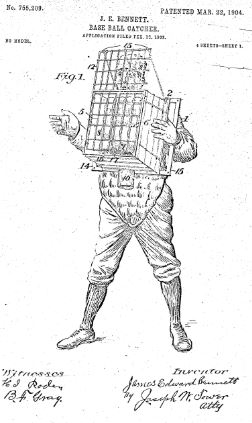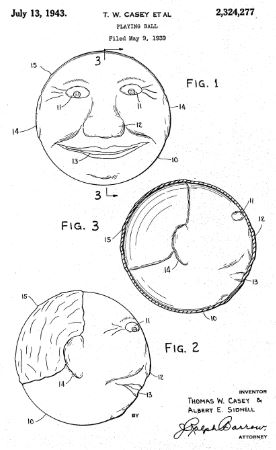As the NCAA Men’s College World Series comes to an end, fans from around the country are gathering in Omaha, Nebraska to root for their favorite team.
In honor of the “Greatest Show on Dirt,” we would like to share a few interesting inventions and patents in baseball history.
“Base-ball catcher” U.S. Patent No. 755,209
Unlike what you may see at the Men’s College World Series, catchers initially wore no protective equipment in baseball’s early years. They were commonly perceived as glorified backstops, distancing themselves from the batter, focused on preventing each pitch from getting away. As the game evolved, and more pitchers began throwing overhand, catchers needed better equipment to protect themselves. In 1904, James Bennett thought of a solution he called the “Base Ball Catcher.”
Bennett’s patented device was a rectangular open-wire frame body reinforced by slotted walls of wood. Springs at the rear of the device were put into place to protect catcher’s chest from the blow of each pitch. Once the baseball passed through the front end, the contraption would drop the ball into the catcher’s hands so they could throw it back to the pitcher.
“Playing ball” U.S. Patent No. 2,324,277
While we’re reasonably confident this baseball never made its debut in a College World Series game, it would be remiss of us not to share this strange patent. In 1939, Thomas Casey filed a patent for a new kind of baseball in hopes that it would be a big hit with children everywhere. In 1943, Casey’s patent was granted, and while the face did not have a name, it sure is memorable.
“Ball bat” U.S. Patent No. 838,257
Unlike many aspects of the game, the baseball bat has been left primarily unchanged since the 19th century. Originally, bats tended to be much larger and more substantial than todays. The thinking was that the bigger the bat, the more mass behind the swing, and the bigger the hit.
In 1890, Emile Kinst was concerned with not only the bat’s size but how a bat could put a greater spin on batted balls. Thus, Kinst introduced a curved design for bats and was eventually granted a patent for “Ball Bat” in 1906.
“The object of my invention is to provide a ball-bat which shall produce a rotary or spinning motion of the ball in its flight to a higher degree than is possible with any present known form of ball-bat, and thus to make it more difficult to catch the ball.”
It is important to note that at the time of Kinst’s invention, baseball gloves were not yet universally accepted, so a rapidly spinning ball would be far more difficult to field. While Kinst’s “Ball bat” was never widely used, several were produced and named by the public as, “banana bats.”
“Retractable baseball bat” U.S. Patent No. 7,166,046
While baseball bats have not undergone many structural changes historically, this patent seems like it could be useful to younger individuals learning how to play the game.
Chao-Jih Liu was granted a patent for his “Retractable baseball bat” in 2007. This bat is made of an ethylene vinyl acetate (EVA) foam material that can be expanded and contracted to fit the intended user’s physical size. While the retractable bat doesn’t appear on the NCAA’s list of Certified Bats, we still appreciate its ingenuity.

“Container for holding popcorn and a drink cup” U.S. Patent No. 4,491,220
Hot dogs, peanuts, cotton candy, nachos… There never seems to be a shortage of delicious food at TD Ameritrade Park; However, if you’re bringing children to the games this week, it’s almost guaranteed that you will run out of hands to hold all of the scrumptious snacks available. On January 1, 1985, Gilbert P. Daviss created a solution to this issue he called, “Container for holding popcorn and a drink cup.”

With the return of alcohol sales to the College World Series, it might not be long before baseball fans are utilizing a gadget like this to enjoy their cold refreshing drink with popcorn or peanuts.
If you find yourself pondering the intellectual property behind “America’s Great Pastime,” you can email your questions to info@suiter.com. We’re also active on Facebook and Instagram. If you’re visiting Omaha for the College World Series, we hope you enjoy your stay in the city we call home.



